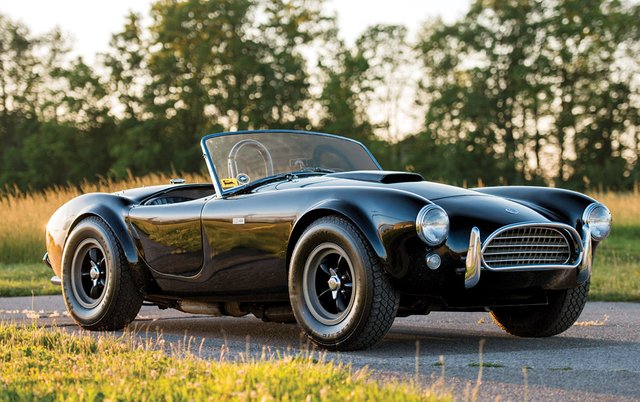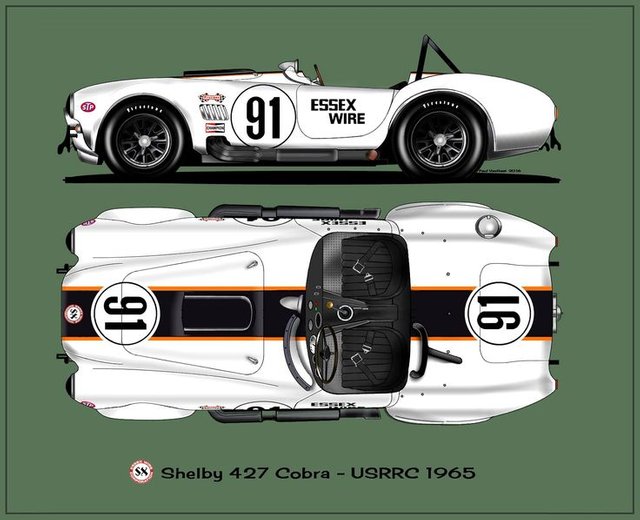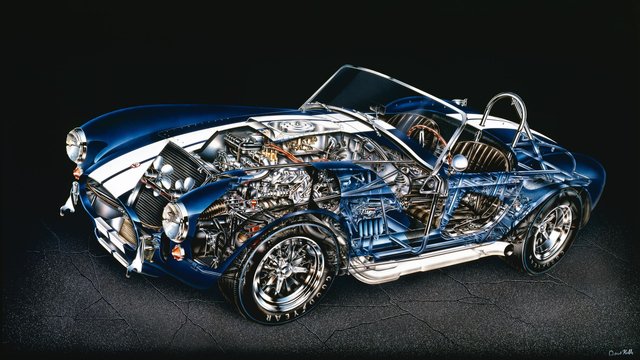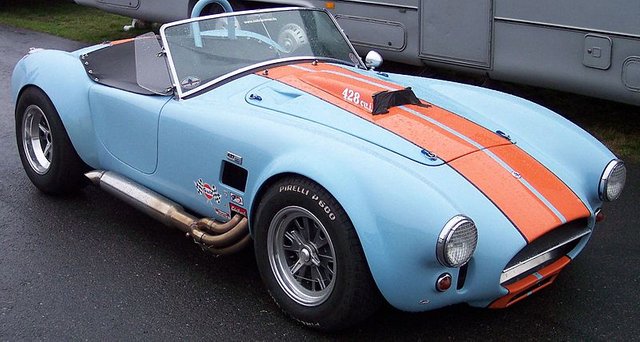


Car Specs
Engine: 7.0L V8 SuperchargedWeight: 1,035 kg / 2,281 lbsPower: 305 kW / 409 hp0-100 kph: 4.6 secondsTorque: 626 Nm / 461 lb-ftTop Speed: 265 kph / 164 mph

The AC Cobra, sold as the Shelby Cobra in the United States, is an Anglo-American sports car with a Ford V8 engine, produced intermittently in both the UK and the US since 1962History and development Like many British manufacturers, AC Cars had been using the Bristol straight-6 engine in its small-volume production, including its AC Ace two-seater roadster. This had a hand-built body with a steel tube frame, and aluminium body panels that were made using English wheeling machines. The engine was a pre-World War II design by BMW which by the 1960s was considered dated. Bristol decided in 1961 to cease production of its engine and instead to use Chrysler 313 cu in (5.1 L) V8 engines. AC started using the 2.6 litre Ford Zephyr engine in its cars.In September 1961, American automotive designer Carroll Shelby wrote to AC asking if they would build him a car modified to accept a V8 engine. AC agreed, provided a suitable engine could be found. Shelby went to Chevrolet to see if they would provide him with engines, but not wanting to add competition to the Corvette they said no. However, Ford wanted a car that could compete with the Corvette and they happened to have a brand new engine which could be used in this endeavor: the Windsor 221 in³ (3.6 L) engine – a new lightweight, thin-wall cast small-block V8. Ford provided Shelby with two engines.AC Ace 3.6 In January 1962 mechanics at AC Cars in Thames Ditton, Surrey designed the "AC Ace 3.6" prototype with chassis number CSX2000.AC had already made most of the modifications needed for the small-block V8 when they installed the 2.6 litre inline 6 Ford Zephyr engine, including the extensive rework of the AC Ace's front end bodywork. The only modification of the front end of the first Cobra from that of the "AC Ace 2.6" was the steering box, which had to be moved outward to clear the wider V8 engine.The most important modification was the fitting of a stronger rear differential to handle the increased engine power. A Salisbury 4HU unit with inboard disc brakes to reduce unsprung weight was chosen instead of the old E.N.V. unit. It was the same unit used on the Jaguar E-Type. After testing and modification, the engine and transmission were removed and the chassis was air-freighted to Shelby in Los Angeles on 2 February 1962,[8] By this time the small-block's displacement was increased to 260 in3 (4.3 L).Shelby's team paired this engine along with a transmission into CSX2000, in less than eight hours at Dean Moon's shop in Santa Fe Springs, California, and began road-testing.Production (CSX/CS 2001–2602)A few edits were made to the production version:Inboard brakes were moved outboard to reduce cost. The fuel tank filler was relocated from the fender to the center of the trunk. The trunk lid had to be shortened to accommodate this change. AC exported completed, painted, and trimmed cars (less engine and gearbox) to Shelby who then finished the cars in his workshop in Los Angeles by installing the engine and gearbox and correcting any bodywork flaws caused by the car's passage by sea. A small number of cars were also completed on the East Coast of the USA by Ed Hugus in Pennsylvania, including the first production car; CSX2001.The first 75 Cobra Mk1 models (including the prototype) were fitted with the 260 cu in (4.3 L).[9] The remaining 51 Mk1 models were fitted with a larger version of the Windsor Ford engine, the 289 cu in (4.7 L) V8.In late 1962 Alan Turner, AC's chief engineer completed a major design change of the car's front end to accommodate rack and pinion steering while still using transverse leaf spring suspension. The new car entered production in early 1963 and was designated Mark II. The steering rack was borrowed from the MGB while the new steering column came from the VW Beetle. About 528 Mark II Cobras were produced in the summer of 1965 (the last US-bound Mark II was produced in November 1964).European model (COB/COX 6001–6062)In 1963 to keep production focused on producing cars for Shelby American Inc., the Ruddspeed Ace was discontinued. To supply cars to the European market, AC began to market and sell the Cobra in Europe. Advertisements from the time state that the Cobra was designed to meet the requirements of Shelby American Inc.390 Big Block Cobra Shelby experimented with a larger Ford FE engine, of 390 cubic inches (6.4 L) in chassis number CSX2196. Unfortunately the car was not able to receive the development it needed, as resources were aimed at taking the crown from Ferrari in the GT class. Ken Miles drove and raced the FE-powered Mark II at Sebring and pronounced the car virtually undriveable, naming it "The Turd". It failed to finish with the engine expiring due to damper failure.CSX2196 was revised for the show down at Nassau which allowed a more relaxed class division of racing. This allowed the GT cobras to run with prototype Ford GT, GM Grand Sport Corvettes and Lola Mk.6. It was for this event in 1964 that the Fliptop cobra was used. An aluminium 390 cubic inches (6.4 L) engine was used. However, the car failed to finish.Cobra 427 A new chassis was required, developed, and designated Mark III. The new car was designed in cooperation with Ford in Detroit. A new chassis was built using 4 in (101.6 mm) main chassis tubes, up from 3 in (76.2 mm) and coil spring suspension all around. The new car also had wide fenders and a larger radiator opening. It was powered by the "side oiler" Ford 427 cu in (7.0 L) FE engine rated at 425 bhp (431 PS; 317 kW) @ 6000 rpm and 480 lb⋅ft (651 N⋅m) @ 3700 rpm of torque,[10] which provided a top speed of 164 mph (262 km/h) in the standard model and 485 bhp (362 kW) with a top speed of 185 mph (298 km/h) in the competition model.COMPETITION MODELS(CSX/CSB 3001–3100)Cobra Mark III production began on 1 January 1965; two prototypes had been sent to the United States in October 1964. Cars were sent to the US as unpainted rolling chassis, and they were finished in Shelby's workshop.Unfortunately, The MK III missed homologation for the 1965 racing season and was not raced by the Shelby team. Only 56 of the 100 planned cars were produced. Of those, 31 unsold competition models were detuned and fitted with windscreens for street use. Called S/C for semi-competition, an original example can currently sell for 1.5 million USD, making it one of the most valuable Cobra variants.[11]PRODUCTION MODELS(CSX/CSB 3101–3360)Some Cobra 427s were actually fitted with Ford's 428 cubic inches (7.01 L) engine, a long stroke, smaller bore, lower cost engine, intended for road use rather than racing. The AC Cobra was a financial failure that led Ford and Carroll Shelby to discontinue importing cars from England in 1967.AC 289 Sports (COB/COX 6101–6132)AC Cars kept producing the coil-spring AC Roadster with narrow fenders and a small block Ford 289. It was built and sold in Europe until late 1969.Packages DRAGON SNAKEShelby offered a drag package, known as the Dragon Snake, which won several NHRA National events with Bruce Larson or Ed Hedrick at the wheel of CSX2093.[12]Only Six 289 Dragon Snake Cobras were produced by the factory. 2019, 2357 as factory team cars. 2248, 2416, 2427, 2472 as private team cars.One 427 Dragon Snake, 3198.Cobras were also prepared by customers using the drag package. Examples include: 2075, 2093, 2109, 2353, and 3159 "King Cobra."SLALOM SNAKEDesigned for auto-cross events, only two examples were produced. Both had white exterior paint (with red racing strings) and red leather interiors.CSX2522 "Slalom Special"CSX2537 "Slalom Snake"Equipped almost identically to CSX2522, this second example had aluminum valve covers, a tuned air cleaner, a Smiths heater, seat belts, front and rear brake cooling ducts, a hood scoop, brake cooling scoops, side exhausts and a painted roll bar (2522’s roll bar was chromed). Suspension options included Koni shock absorbers, front and rear anti-sway bars, unpolished six-inch magnesium pin-drive wheels, and Goodyear Blue Streak Sports Car Special tires.SUPER SNAKEIn 1966, CSX 3015 S/C was selected and converted into a special model called the Supersnake the "Cobra to End All Cobras." Originally part of a European promotional tour before its conversion. This conversion called for making the original racing model street legal with mufflers, a windshield and bumpers amongst other modifications. But some things were not modified, including the racing rear end, brakes and headers. The most notable modification is the addition of Twin Paxton Superchargers, TPS.Shelby crafted a second model, CSX 3303, from a street version. CSX 3303 was given to comedian Bill Cosby, his close friend. When Cosby attempted to drive CSX3303, he found that it was very difficult to keep under control; he later recounted the experience on his 1968 stand-up comedy album 200 M.P.H.. Cosby gave the car back to Shelby, who then shipped it out to one of his company's dealers in San Francisco, S&C Ford on Van Ness Avenue. S&C Ford then sold it to customer Tony Maxey. Maxey, suffering the same issues as Cosby did with the car, had his throttle stick while leaving a traffic stop, lost control and drove it off a cliff, landing in the Pacific Ocean waters.[13]Shelby used his CSX 3015 as a personal car over the years, sometimes entering it into local races like the Turismos Visitadores Cannonball-Run race in Nevada, where he was "waking [up] whole towns, blowing out windows, throwing belts and catching fire a couple of times, but finishing."[14] CSX3015 was auctioned on 22 January 2007, at the Barrett-Jackson Collector Car Event in Scottsdale, Arizona, for $5 million plus commission (£2.8 million), a record for a vehicle made in the U.S.[15][16]Adaptations (CF/CFX 01-80)AC also produced the AC 428 Frua on a stretched Cobra 427 MK III coil spring chassis. The steel body was designed and built by Pietro Frua until 1973.(EF/EFX 501–508)The American Electric Car Company used an even further modified chassis for their vehicles.GHIA SPYDER[17](CSX 5001–5002)One 96-inch prototype chassis (CSX 3063) was shipped to GHIA in Italy in 1965 for a body styling exercise. This vehicle was first displayed during a European car show with a Cobra license tag. An article about the car was written up in the Winter 65/66 edition of "Style Quarterly" magazine. Shelby American internal production records show that the car was shipped to Shelby American for Evaluation and review. AC Cars Ltd internal production records show that Shelby American placed an order for two 96-inch chassis (CSX 5001–5002) in 1966. AC labeled these chassis as "GHIA CONVERTIBLE" in their factory ledger.FORD XD COBRA[18](CSX 3001)Shelby American internal production records show that the car was shipped to Shelby American for evaluation and review in early 1966. The vehicle was returned to Ford and now resides in the Detroit Historical Museum.AutoKraft By 1982, the Ac name was licensed by Autokraft, a Cobra parts reseller and replica car manufacturing company owned by Brian A. Angliss. Autokraft also had acquired the company's tooling.Autokraft manufactured an AC 289 continuation car called the Autokraft Mk IV, basically a Mk III with a 302 cubic inches (4.95 L) Ford V8 and Borg Warner T5 Transmission. The Mk IV also received an independent suspension.In 1986, Autokraft (as a joint venture with Ford joining in 1987) purchased AC Cars, and produced the AC Mk IV Cobra, with a 250 hp (186 kW) at 4,200 rpm, 4,942 cc Ford V8, which provided a top speed of 215 km/h (134 mph) and 0–100 km/h in 5.2 seconds.At the 1990 Geneva Salon the Lightweight version was presented: weight was down to 1,070 kg (2,360 lb) (compared to 1,190 kg or 2,620 lb) and power was up to 370 hp (276 kW) at 5,750 rpm thanks to alloy heads, a Holley four-barrel carburettor, and no catalytic converter.[19] While the Lightweight did not meet US federal regulations, the Mk IV did, and 480 cars of all versions were built until 1996.AC Car Group In 1996 the company was purchased by Pride Automotive. Two new 'Cobra' style cars were launched in 1997, the 'Superblower', an aluminium-bodied car with a supercharged 4,942cc Ford V8 providing 320 bhp and the cheaper 'Carbon Road Series' (CRS) with a carbonfibre body and a 225 bhp version of the Ford V8 engine. 22 Superblowers and 37 CRSs were built between 1997 and 2001.In 1999, a limited edition run of 25 289 FIA Cobras were planned. Only 1 example was manufacturered, chassis number COB 1001.A further variant, 'the 212 S/C' with a 3506 cc 350 hp twin-turbocharged Lotus V8 engine was introduced in 2000, but only two examples were built.In 2001, the company relocated its factory to Frimley, Surrey. By August 2002, the company was in a financial low and briefly acquired by Private Corp, who closed operations in October 2003. Only two models were produced, a FIA 289 (COX 2610), and a 427 Cobra (COX 3361). The cars were intended to be sold in the USA market, through a new company, AC Cars USA, in Florida. Both cars were numbered following where the original ledger entries left off during the 1960s.AC Motor Holdings Ltd On July 8, 2002, a new company was formed in Malta named AC Motor Holdings and was responsible for the branding of the company.In late 2003, the Frimley factory was under the control of AC Motor Holdings.On December 4, 2003, Shelby and AC announced a co-production of the CSX1000 and CSX 7500 series. Only 14 CSX1000, and 2 CSX 7500 cars were built by 2007.Between 2004 and 2007, AC Motor Holdings produced the AC Mk V in their Malta factory. However, only 3 right-hand drive and 2 left-hand drive carbon-fibre AC Mk Vs powered by 340 bhp 5-litre Ford V8 engines were built before the Maltese operation closed.Acedes Holdings Llc On April 20, 2008, AC announced its Heritage Series, the UK operations were granted to Brooklands Motor Company, dba AC Heritage. The USA operations were granted to AC AutoKraft, Llc, of Michigan.Both companies are licensed to produce traditional aluminum-body models: Ruddspeed, 289, and 427 continuation Aces and Cobras.In 2009, AC licensed Gullwing GmbH in Germany, dba AC-Automotive, to produce the AC MK VI, with an aluminium coated composite body and powered by a 6.2-litre 440 hp LS3 Chevrolet engine, or a 550 hp supercharged version.In 2012, the AC Mrk II Classic was released. Available in either aluminum or fiberglass bodies.In 2017, the AC Mrk1 260 Legacy edition was released in a limited production of nine cars. Also released was the AC 378 a newer composite body version of the Cobra.Shelby Daytona Coupé In an effort to improve top speed along the legendary Mulsanne Straight at the 24 Hours of Le Mans race, a number of enclosed, coupe variations were constructed using the leafspring chassis and running gear of the AC/Shelby Cobra Mark II. The most famous and numerous of these were the official works Shelby Daytona Cobra Coupes. Six were constructed, each being subtly different from the rest.AC Cars also produced a Le Mans coupé. The car was a one-off and was nearly destroyed after a high-speed tire blow-out at the 1964 Le Mans race. The car was qualified conservatively second in GT. The race started well with the AC, chassis number A98, maintaining its position in the top two in GT and even leading the class for a time. This was not to last as an act of sabotage (newspaper in the fuel tank) began to block the fuel filter. The car lost time until this was diagnosed and cleaned out.[citation needed] The car proceeded on at the predetermined conservative lap time and for the next stint remained trouble free. The car was able to match the Shelby Daytona's speed despite running a higher differential ratio (2.88 instead of 3.07) and a lower state of engine tune for reliability (355 hp instead of the Daytona's 385 hp).The Willment race team became interested in Shelby's Cobra-based coupe and inquired on purchasing one. Shelby turned down the offer, but supplied the drawings to Willment. Dubbed the Willment Cobra Coupe, this car was fully built by the JWA racing team and numbered 2131 on the frame.427 Super Coupes A prototype (CSX 3027) was to become 427 Coupe, but since the focus was shifted towards the GT program, this project received little attention. The bodywork and chassis were soon scrapped.[20]Two further chassis were ordered number CSX 3054 and CSX 3055. This project was also abandoned with just CSX 3054 receiving a body. CSX 3055 was sold to the Willment Race Team and was fitted with a Fiat body designed by Ghia.Counterfeit Cobras In 1993 the Los Angeles Times exposed a Carroll Shelby scheme[21] to "Counterfeit" his own cars. With the price of an original 427 c.i. Cobra skyrocketing, Shelby had, by his own written declaration executed under penalty of perjury, caused the California Department of Motor Vehicles (the government agency responsible for titling vehicles and issuing operator permits) to utter forty-three "Duplicate Titles" for vehicles that did not officially exist in company records. A letter from AC Cars confirmed the fact that the chassis numbers Shelby had obtained titles for were never manufactured, at least by AC Cars. Only fifty-five 427 c.i. Cobras had been originally produced out of a block of serial numbers reserved for 100 vehicles. Shelby had taken advantage of a loophole in the California system that allowed one to obtain a duplicate title for a vehicle with only a written declaration, without the vehicle identification number appearing in the DMV's database or the declarant ever presenting an actual vehicle for inspection.[22] Shelby later admitted[22] that the chassis had been manufactured in 1991 and '92 by McCluskey Ltd, an engineering firm in Torrance, California, and were not authentic AC chassis.Continuation Cars Since the late 1980s onwards, various companies have built what are known in the hobby as "Continuation Cars".Shelby authorized continuations of the original AC-built Cobra series. Produced in Las Vegas, Nevada, these cars retain the general style and appearance of their original 1960s ancestors, but are fitted with modern amenities. Initially the car everyone wanted in a Continuation was a 427 S/C model which was represented in the CSX4000 series. This was meant to continue where the last 427 S/C production left off, at approximately serial number CSX3660 in the 1960s.The initial CSX4000 series cars were completed from the chassis built by McCluskey Ltd as well as other new parts and reconditioned Ford engines. Given the value of the vehicle many "extra" cars have appeared over the years, even some sharing the same chassis number. Gradually as the vintage parts supply ran low, newly constructed frames and body panels were obtained from a variety of suppliers. The production of chassis numbers CSX4001 to CSX4999 took roughly 20 years and many different business relationships to complete.In 2009, CSX4999 was produced, concluding the 4000 series. Production has continued with the CSX6000 serial numbers, featuring "coil over" suspension.The 289 FIA "leaf spring" race version of the car is reproduced as CSX7000, and the original "slab side" leaf spring street car is the CSX8000 series. The Daytona Coupe is reproduced as the CSX 9000 series.To date most continuations are produced in fiberglass, with some ordering cars with aluminium or carbon-fibre bodywork.In 2004, at the North American International Auto Show in Detroit, Ford unveiled a concept for a modernized AC Cobra. The Ford Shelby Cobra Concept was a continuation of Ford's effort to bring back the retro sports cars that had been successful in the 1960s, including the Ford GT40 and the fifth generation Ford Mustang.In 2014 Shelby American announced a limited edition production of 50 cars for the 50th anniversary of the original 427 Shelby Cobra.

Hi! I am a robot. I just upvoted you! I found similar content that readers might be interested in:
https://everipedia.org/wiki/AC_Cobra/
Downvoting a post can decrease pending rewards and make it less visible. Common reasons:
Submit